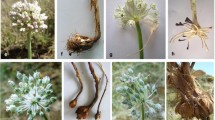Abstract
Restriction fragment length polymorphism (RFLP) markers were used in combination with genomic in situ hybridisation (GISH) to investigate the origin of the allotetraploid species Coffea arabica (2n = 44). By comparing the RFLP patterns of potential diploid progenitor species with those of C. arabica, the sources of the two sets of chromosomes, or genomes, combined in C. arabica were identified. The genome organisation of C. arabica was confirmed by GISH using simultaneously labelled total genomic DNA from the two putative genome donor species as probes. These results clearly suggest that C. arabica is an amphidiploid formed by hybridisation between C. eugenioides and C. canephora, or ecotypes related to these diploid species. Our results also indicate low divergence between the two constituent genomes of C. arabica and those of its progenitor species, suggesting that the speciation of C. arabica took place relatively recently. Precise localisation in Central Africa of the site of the speciation of C. arabica, based on the present distribution of the coffee species, appears difficult, since the constitution and extent of tropical forest has varied considerably during the late Quaternary period.
Similar content being viewed by others
Author information
Authors and Affiliations
Additional information
Received: 6 June 1998 / Accepted: 10 November 1998
Rights and permissions
About this article
Cite this article
Lashermes, P., Combes, MC., Robert, J. et al. Molecular characterisation and origin of the Coffea arabica L. genome. Mol Gen Genet 261, 259–266 (1999). https://doi.org/10.1007/s004380050965
Issue Date:
DOI: https://doi.org/10.1007/s004380050965




